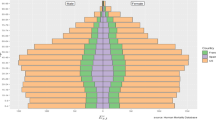Abstract
This paper is motivated by the need to have appropriate tools for the valuation of mortality/longevity risks when carrying out an internal assessment of the insurance business, such as a portfolio valuation or a solvency investigation based on internal models. The case of life annuities is in particular addressed, due to the importance of mortality/longevity on the cost of living benefits for the elderly. Our aim is to describe a stochastic mortality model calibrated on the best-estimate life table available to the insurer and to the mortality experienced in the insurer’s portfolio. As we address life annuities, uncertainty of future mortality improvements, i.e. the aggregate mortality/longevity risk, needs in particular to be accounted for. Following Olivieri and Pitacco (ASTIN Bull 39(2):541–563, 2009), we extend some classical results about the modeling of the number of deaths joint to the modeling of parameter uncertainty. We explore the features of two alternative approaches: a Beta-Binomial and a Poisson-Gamma setting; we then focus on the latter only. Thanks to a Bayesian inferential procedure, the parameters, initially assigned referring to the best-estimate life table, are updated according to the mortality experienced in the portfolio. Extending a traditional tool-kit, the framework we define is in particular suitable for practical work. Due to calibration, clearly the scope of the model is within internal assessments. To provide an example of application of the model, we perform a capital assessment. Solvency rules which could be adopted as an alternative to a standard, regulatory requirement are tested. The Solvency 2 requirement for longevity risk is referred to for the design of an internal rule which could get validation for replacing the standard one.







Similar content being viewed by others
References
Biffis E (2005) Affine processes for dynamic mortality and actuarial valuations. Insur Math Econ 37(3):443–468
Biffis E, Millossovich P (2006) A bidimensional approach to mortality risk. Decis Econ Finance 29:71–94
Brémaud P (1981) Point processes and queues. Martingale dynamics. Springer, Berlin
Bühlmann H (1970) Mathematical methods in risk theory. Springer, New York
Cairns A, Blake D, Dowd K (2006) Pricing death: frameworks for the valuation and securitization of mortality risk. ASTIN Bull 36(1):79–120
Carlin B, Louis T (2000) Bayes and empirical Bayes methods for data analysis. Chapman & Hall/CRC, Boca Raton
CEIOPS (2009) Consultation paper no. 39–62
CMI: An interim basis for adjusting the “92” series mortality projections for cohort effects (2002) Working paper 1, The Faculty of Actuaries and Institute of Actuaries
CMI: Stochastic projection methodologies: Further progress and P-Spline model features, example results and implications (2006) Working paper 20, The Faculty of Actuaries and Institute of Actuaries
Dahl M (2004) Stochastic mortality in life insurance. Market reserves and mortality-linked insurance contracts. Insur Math Econ 35(1):113–136
Dahl M, Møller T (2006) Valuation and hedging of life insurance liabilities with systematic mortality risk. Insur Math Econ 39(2):193–217
Gerber H (1995) Life insurance mathematics. Springer, Berlin
Haberman S, Olivieri A (2008) Risk classification/life. In: Melnick E, Everitt B (eds) The Encyclopedia of Quantitative Risk Assessment and Analysis. Wiley, Chichester, pp 1535–1540
Lin Y, Cox S (2008) Securitization of catastrophe mortality risks. Insur Math Econ 42(2):628–637
Marocco P, Pitacco E (1998) Longevity risk and life annuity reinsurance. In: Transactions of the 26th international congress of actuaries, Birmingham, vol 6, pp 453–479
Olivieri A (2001) Uncertainty in mortality projections: an actuarial perspective. Insur Math Econ 29(2):231–245
Olivieri A (2006) Heterogeneity in survival models. applications to pensions and life annuities. Belgian Actuar Bull 6:23–39
Olivieri A, Pitacco E (2002) Inference about mortality improvements in life annuity portfolios. In: Transactions of the 27th international congress of actuaries, Cancun (Mexico)
Olivieri A, Pitacco E (2009) Stochastic mortality: the impact on target capital. ASTIN Bull 39(2):541–563
Panjer H, Willmot G (1992) Insurance risk models. The Society of Actuaries
Robert C, Casella G (2004) Monte Carlo statistical methods. Springer, Berlin
Sandström A (2006) Solvency. Models, assessment and regulation. Chapman & Hall/CRC Press, Boca Raton
Vaupel J, Manton K, Stallard E (1979) The impact of heterogeneity in individual frailty on the dynamics of mortality. Demography 16(3):439–454
Willets RC (2004) The cohort effect: insights and explanations. Br Actuar J 10:833–877
Acknowledgments
The author thanks the anonymous referees for useful suggestions and remarks. Financial support from Italian MIUR is kindly acknowledged.
Author information
Authors and Affiliations
Corresponding author
Rights and permissions
About this article
Cite this article
Olivieri, A. Stochastic mortality: experience-based modeling and application issues consistent with Solvency 2. Eur. Actuar. J. 1 (Suppl 1), 101–125 (2011). https://doi.org/10.1007/s13385-011-0013-5
Received:
Accepted:
Published:
Issue Date:
DOI: https://doi.org/10.1007/s13385-011-0013-5




